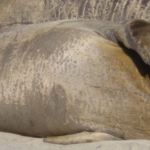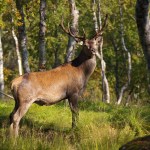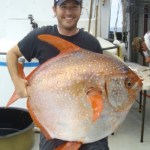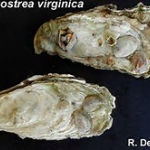
I am excited to present this guest blog from Bridget Martinez, graduate student from the University of California, Merced. She has been studying elephant seals in the laboratory of Dr. Rudy Ortiz. She had presented her research at the 2015 Experimental Biology conference in Boston, MA which was mentioned in a prior blog . Here is her description of her research:.
---------
Bridget Martinez, Graduate Student, University of California - Merced
Northern elephant seals (Mirounga angustirostris) (NES) are fascinating mammals; they possess the incredible ability to fast for weeks without…
Just one more example of how much humans and chimpanzees have in common. Check out this podcast describing wild chimpanzees seen drinking fermented tree sap as well as the video below.
Supplement video uploaded by the study's authors (Hockings et al., Royal Society Open Science, 2015) on Youtube.
Sources:
Scientific American
KJ Hockings, N Bryson-Morrison, S Carvalho, M Fujisawa, T Humle, WC McGrew, M Nakamura, G Ohashi, Y Yamanashi, G Yamakoshi, T Matsuzawa. Tools to tipple: ethanol ingestion by wild chimpanzees using leaf-sponges. Royal Society Open Science. DOI: 10.1098/rsos.150150 (…
If you have not already had a chance to see it, the T. Rex Autopsy airing on the National Geographic channel is a must-see! They literally created a model of T. Rex based on available evidence about T. Rex and other dinosaurs as well as evidence from modern birds and then performed an "autopsy". The conclusion: T. Rex was basically a 'big angry chicken' - Love it!!
It will be airing again tomorrow night at 10/9 central.
For more information and a sneak preview:
Images from National Geographic website.
Check out the tiny new species of frogs discovered in the cloud forests of Brazil.
Brachycephalus mariaeterezae
Brachycephalus fuscolineatus
Brachycephalus verrucosus
Brachycephalus leopardus
Brachycephalus boticario
Brachycephalus olivaceus
Images from LiveScience.
Image of a red deer from Wikimedia Commons. Image by: Jörg Hempel
Dr. Walter Arnold (University of Vienna) and colleagues were interested in studying how Northern ungulates cope (physiologically) with limited food supplies during the winter months. Ungulates are known to reduce energy expenditure during the winter. A new study published Wednesday in the American Journal of Physiology-Regulatory, Integrative and Comparative Physiology describes how these animals adjust their nutritional intake. Dr. Arnold's team examined intestinal transport of…
Speaking of octopuses, the ability for the animals to squeeze through narrow openings has inspired the creation of a new surgical robotic device that can squeeze into a patient's body.
An EU team created STIFFness controllable Flexible and Learnable manipulator for surgical OPerations, dubbed "STIFF-FLOP", made from silicone. Unlike conventional robots used during surgeries, the idea behind STIFF-FLOP is to be able to navigate around organs inside the body and minimize potential damage to healthy tissues. Its movements are controlled by pneumatic actuators. To create stiffness, they…
New research shows how octopus skin is able to respond to variations in light
Dr. Stan Lindstedt, Northern Arizona University Recipient of the 2013 August Krogh lectureship, American Physiological Society, Comparative and Evolutionary Physiology section
I am thrilled to see Dr. Stan Lindstedt's review article published in the April 2015 issue of American Journal of Physiology: Regulatory, Integrative and Comparative Physiology from his 2013 August Krogh lectureship at the annual Experimental Biology conference. My original blog from the lecture can be found here.
Dr. Lindstedt and co-author Dr. Niisa Nishikawa (Northern Arizona University), describe the…
Dr. Vivek Jayaraman and colleagues at the Howard Hughes Medical Institute Janelia Research Campus discovered that the ellipsoid body located in the middle of a fly's brain acts like a compass to help navigate flight even in darkness. By placing the flies into a small virtual reality arena and having the flies walk on a rotating ball, they could study the activity of neurons within the ellipsoid body while the animal was moving.
These videos show how the fly experiment was done:
Check out the news release for more information about this neat study.
Nick Wegner (Southwest Fisheries Science Center) is pictured here holding an opah. Image Credit: NOAA Fisheries, Southwest Fisheries Science Center
The opah (Lampris guttatus), otherwise known as a moonfish, lives in the deep sea where warm blood can be advantageous. According to a quote from Nicholas Wegner (NOAA) posted in Live Science, "Increased temperature speeds up physiological processes within the bod. As a result, the muscles can contract faster, the temporal resolution of the eye is increased, and neurological transmissions are sped up. This results in faster swimming speeds…
Image from www.antforum.nl
Many species of ants are known for being rather clean by disposing of their dead outside of the nest and placing other wastes, like bits of food, in refuse chambers. Dr. Tomer J. Czaczkes (University of Regensburg) was surprised therefore to see "dark patches" build up in plaster nests that housed black garden ants (Lasius niger). Dr. Czaczkes suspected that these dark patches might actually be feces. He tested this hypothesis by adding food coloring to their diet. Perhaps not surprisingly, the dark patches changed to shades of blue and red.
Several theories…
Professor Wayne Vogl and colleagues at the University of British Columbia discovered that rorqual whales can gulp volumes of water that are bigger than their body. Nerves in the mouth and tongue make this amazing feat possible as they can actually stretch to twice their resting length without sustaining damage. Dr. Vogl was quote in CBC News saying, "The nerves that supply these remarkably expandable tissues in the floor of the mouth of rorqual whales ... are very stretchy, they're like bungee cords." This is unusual as the nerves of most vertebrate species have…
Dr. Frank van Breukelen, Comparative Physiologist, University of Nevada, Las Vegas
Dr. Frank van Breukelen is an Associate Professor in the School of Life Sciences at the University of Nevada, Las Vegas. He was invited to tell us about a new research project in this laboratory about some really cool mammals called tenrecs.
Here is the post:
In a recent post, Dr. Dolittle mentioned a talk that we gave at the Experimental Biology meetings in Boston. We discussed some of our recent data on tenrecs in a symposium about physiological plasticity- the ability of an animal to change its physiology…
Image of sheep from Wikimedia Commons
Insulin is a major hormone responsible for regulating blood sugar. Its main function is to lower sugar by increasing glucose uptake into muscle and fat cells. Insulin resistance is the hallmark of type 2 diabetes and occurs when tissues in the body are not able to respond to insulin resulting in sustained elevations in blood sugar, also known as hyperglycemia.
An alternative mechanism for lowering blood sugar is muscle contraction as it stimulates a pathway distinct from insulin in the muscles to cause glucose uptake from the blood. Exercise…
Hats off to all of the comparative physiologists who were recognized for their hard work and exciting research at the 2015 annual Comparative and Evolutionary Physiology Business meeting at the Experimental Biology conference earlier this month. I thought I would take a moment to recognize each awardee:
Arthur DeVries (left), University of Illinois: 2015 Krogh Distinguished Lecturer (Image Credit: Tom Ecay, CEPS Secretary)
Karen Sweazea, Arizona State University: New Investigator Award (Image credit: Tom Ecay, CEPS Secretary)
Csilla Ari, University of South Florida: Research…
I am listening Pretoria! Since there have been so many wonderful discussions led by students from the University of Pretoria over the last couple of years (refer to the comments), I thought I would recognize this wonderful place. First of all, thank you for being so actively involved in the blog for your classes. I am sure your professors are proud. Since the university has over 230 different degrees, diplomas or certificates, I cannot determine which program you are from, but I appreciate your support.
Nature reserves and walks in Pretoria, South Africa are home to an…
Yesterday was the final day of the meeting with many late breaking poster presentations as well as this year's Nobel Laureate lecture.
This year's American Physiological Society Nobel Prize in Physiology or Medicine Lecture was given by Dr. Robert J Lefkowitz from Howard Hughes Med. Inst. and Duke Univ. Med. Ctr. He was awarded the Nobel prize in Chemistry in 2012. What makes him famous is a tiny receptor located in the plasma membrane of cells called the G-protein coupled receptor. He is known for discovering the receptor for adrenaline (i.e. the fight or flight…
Yesterday (Tuesday) was another great day for Comparative Physiology!
Congratulations to Dr. Arthur DeVries (above; Professor Emeritus, Department of Molecular and Integrative Physiology; Professor of Animal Biology, University of Illinois), this year's recipient of the August Krogh Distinguished lecturer award from the Comparative and Evolutionary Physiology section of the American Physiological Society. Dr. DeVries gave an excellent seminar summarizing his career studying fish that live in some of the coldest waters without freezing! The fish accomplish this amazing task by having anti-…
I came across this video on YouTube of what must be the most huggable kitty:
Monday was a great day for comparative physiology at EB! I saw several highly notable posters and seminars that I would like to share with you:
Image of a deer mouse from www.calphotos.berkeley.edu
Catherine Ivy, graduate student at McMaster University compared deer mice that were raised at high altitudes versus those raised at lower altitudes and found that the ancestry of the animals was actually important in regulation of breathing and gas exchange in the lungs. Perhaps not surprisingly, acclimation to hypoxia also influenced both variables as well.
Image of a guinea pig from…





